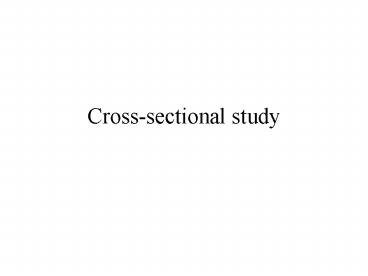Cross-sectional study - PowerPoint PPT Presentation
1 / 18
Title:
Cross-sectional study
Description:
Cross-sectional studies within dietary survey, may measure current diet in a ... A further limitation of cross-sectional studies may be due to errors in recall ... – PowerPoint PPT presentation
Number of Views:246
Avg rating:3.0/5.0
Title: Cross-sectional study
1
Cross-sectional study
2
Definition
1.
- A cross-sectional studies
- a type of observational or descriptive study
- the research has no control over the exposure of
interest (e.q. diet). - It involves
- identifying a defined population at a particular
point in time - measuring a range of variables on an individual
basis - include past and current dietary intake
3
Uses of cross-sectional studies
- Prevalence survey The studies are commonly used
to describe the burden of disease in the
community and its distribution. - Describe population characteristics They are
also commonly used to describe population
characteristics, often in terms of person (who?)
and place (where?) - .e.q.
- The British National Diet and Nutrition Survey
or Nutrition and Health Survey in Taiwan - To describe various age groups in the population
in terms of food and nutrient intake and range of
other personal and lifestyle characteristics.
4
(No Transcript)
5
- Migrant study Some migrant studies may full
into the classification of cross-sectional
studies. These studies give clues as to
association between genetic background and
environmental exposures on the risk of disease. - e.q. A study of the prevalence (percentage) of
coronary heart disease - among men of Japanese ancestry living in Japan,
Honolulu and the San Francisco Bay area - showed the highest rates among those who had
migrated to the United States.
6
(No Transcript)
7
- KAP (knowledges, attitudes, and practices )
study - KAP studies are purely descriptive and help to
build up a better understanding of the behavior
of the population, without necessarily relating
this to any disease or health outcome. - Management tool health service managers and
planners may make use of cross-sectional survey
to assess utilization and effectiveness of
service. - Development of hypothesis Hypotheses on the
causes of disease may be developed using data
from cross-sectional study survey.
8
Limitation of cross-sectional study
- It is not possible to say exposure or
disease/outcome is cause and which
effect.(????????) - Confounding factors may not be equally
distributed between the groups being compared and
this unequal distribution may lead to bias and
subsequent misinterpretation. - Cross-sectional studies within dietary survey,
may measure current diet in a group of people
with a disease. Current diet may be altered by
the presence of disease. - A further limitation of cross-sectional studies
may be due to errors in recall of the exposure
and possibly outcome.
9
Design of cross-sectional survey
- The problem to be studied must be clearly
described and a thorough literature review
undertaken before starting the data collection. - Specific objectives need to be formulated.
- The information has to be collected and data
collection techniques need to be decided. - Sampling is a particularly important issue to
ensure that the objectives can be met in the most
efficient way.
10
- Fieldwork needs planning
- Who is available to collect the data ?
- Do they need training ?
- If more than one is to collect the data then it
is necessary to assess between-observer
variation. - The collection, coding and entry of data need
planning. - A pilot study is essential to test the proposed
methods and make any alternations as necessary. - The steps are summarized in Fig 13.5
11
(No Transcript)
12
(No Transcript)
13
Dietary assessment in cross-sectional studies
- Some characteristics of dietary assessment
methods for cross-sectional studies - Measures an individuals intake at one point in
time. - Does not require long-term follow up or repeat
measures - Valid
- Reproducible
- Suitable
- Cost within study budget
14
Dietary method application
- Food records using household measures have been
used in cross-sectional studies. - The recall method attempts to quantify diet over
a defined period in the past usually 24 hours. - The most commonly used dietary assessment method
which attempts to measure usual intake is the
food frequency questionnaire (FFQ).
15
(No Transcript)
16
(No Transcript)
17
Analysis of cross-sectional study
- Before starting any formal analysis, the data
should be checked for any errors and outlines. - Obvious error must be corrected.
- The records of outliners should be examined
excluded - Checking normality of data distribution.
- e.q. using the Kolmogorov-Smirnov Goodness of Fit
Test.
18
- Standard descriptive statistics can then be used
mean, median, quartiles, and mode measure of
dispersion or variability such as standard
deviation measure precision such as standard
error, and confidence intervals. - Mean can be compared using t-tests or analysis of
variance (ANOVA). - More complex multivariate analysis can be carried
out such as multiple and logistic regression.































